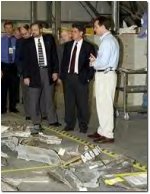
Friday February 21, 12:31 AM
Columbia Probe Examines Foam Insulation

The Columbia accident investigation board is focusing swiftly and intently on how foam insulation was applied to NASA's space shuttles _ territory with a troubled track record.
One leading theory is the insulation or the heavier material beneath may have damaged Columbia during liftoff, enough to trigger a deadly breach as the spaceship hurtled toward a Florida landing Feb. 1.
The foam insulation is applied at a Lockheed Martin plant in New Orleans. More of the foam is applied about a month before liftoff in several small areas of the tank needing touchup at NASA's Kennedy Space Center in Florida.
The investigation board has visited both sites and is going back for a second, harder look at the techniques _ and safeguards _ used.
"That is getting a good bit of attention by more than one of the groups," said NASA's Steve Nesbitt, referring to the board's three working groups. "A couple of the groups are looking at the thermal protection on the tank in this area, and some of them will be going back to see the manufacturing facilities, to talk to the people involved. So it is getting some special attention."
Nesbitt said Thursday the theories that focus on the left side of Columbia _ where all the overheating and other problems developed _ "will be getting the earliest attention." The board suspects a breach in the left wing led to the shuttle's breakup. 1. All seven astronauts were killed.
Friday morning, searchers gathered in Caliente, Nev., to search the desert hills for what is believed to be a piece of Columbia debris that was tracked falling to Earth by air traffic control radar.
Imagery, trajectory and ballistics experts have been analyzing video images of the shuttle as it flew across California and the Southwest. National Transportation Safety Board officials are using those findings to hunt for any unusual radar trackings in an attempt to pinpoint wreckage.
About 25,000 pounds of Columbia debris is now at Kennedy.
Air Force Maj. Gen. John Barry said earlier this week he and other board members are reviewing NASA's troubled history of foam coming off the so-called bipod area, where a pair of struts holds the tank to the upper belly of the shuttle.
That is the spot where a chunk of foam came off 81 seconds into Columbia's flight Jan. 16; the debris slammed into the left wing during launch. An engineering analysis days later concluded any damage was minimal and posed no safety threat.
NASA officials said that finding was based, in part, on the fact that previous foam impacts had not caused severe damage.
Barry said four previous shuttle launches had foam falling from the bipod area: Challenger in 1983, Columbia in 1990 and 1992, and Atlantis last October.
Last week, the board inspected Atlantis and its fuel tank at Kennedy and a completely assembled fuel tank at Michoud Assembly Facility in New Orleans that is identical to the one used by Columbia on its doomed flight. The Michoud tank has been impounded by the board for testing.
NASA estimates the chunk of broken foam was 2.67 pounds and 20-by-16-by-6 inches. The weight would be more if ice were attached, a possibility under consideration by the board. The panel also is looking into whether the underlayer may have come off.
Barry said he has learned the heavier premolded, ablative material beneath the foam "really doesn't serve a purpose." He asked workers whether moisture could have accumulated there and loosened the insulation.
"We're looking at that as maybe an option on why the foam came off and why we've had some problems in that area," he said.
NASA chief Sean O'Keefe confirmed Thursday that one theory being tested by NASA investigators at Michoud is that air bubbles or ice formed under the silicone-based ablator, possibly causing insulation to break free.
O'Keefe also acknowledged that design changes were being considered for this suspect area of the fuel tank before Columbia's flight, but he stressed they were "very minor."
"Certainly, at this point right now, no one is making any changes to any designs until we find out what was the cause or the probable cause of this accident," he said.
At Michoud, polyurethane foam insulation is sprayed robotically about an inch thick over the entire 154-foot tank to prevent ice buildup on the metal tank, which is filled with super-cold liquid hydrogen and oxygen during the final hours of the countdown. The foam also helps protect the tank from engine and aerodynamic heating.
At Kennedy, more foam is applied by hand in the area around the bipod and also around the other attach points.
Internal NASA reports obtained by The Associated Press describe damage during some of the earlier shuttle missions, caused by foam from the bipod area.
Columbia suffered damage to three insulating tiles during a June 1992 liftoff when a large chunk of foam from the bipod _ 26-by-10 inches _ fell off. After the mission, NASA determined that the shuttle fleet had suffered an unprecedented amount of serious tile damage over 18 preceding flights.
The damage to Atlantis in October was not considered significant, at the time, by NASA.
Associated Press writers Ted Bridis in Washington contributed to this report.
Copyright © 2003 The Associated Press. All rights reserved. The information contained in the AP News report may not be published, broadcast, rewritten or redistributed without the prior written authority of The Associated Press.
AviationHistory.org shall not be liable for any errors or delays in the content, or for any actions taken in reliance thereon.
|













